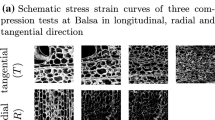Abstract
This article presents a three-dimensional wood material model implemented in finite element (FE) software which is capable of predicting the behavior of timber at the macro-scale taking into account the effect of any type of knot. The model was built in Ansys using the ansys parametric design language, such that the whole simulation process, including the creation of geometries, grain deviation, meshing and failure prediction, is automatically calculated by only introducing conventional measuring parameters of knots and locations of the pith. Knots are generated as elliptical, rotated and oblique cones. The local and global grain deviation is estimated by solving a multiphysics problem and equating the fibers of wood to the trajectory of laminar streamlines in 3-D. Wood is considered a transversely isotropic material with anisotropic plasticity in which the failure prediction is given by means of several phenomenological failure criteria. The model was validated with 4-point bending tests of Scots pine specimens showing errors in failure prediction of 5 %, errors in initial fracture location of less than 20 mm and errors of 9 % in photogrammetrically measured displacements of an average of 65 FE nodes, in which the heterogeneity of wood caused variations of up to 6 %.






Similar content being viewed by others
References
Argüelles B (1994) Prediction of the behavior of wooden pieces by animated simulation. Dissertation (in Spanish), Dissertation, Polytechnic University of Madrid, Madrid
Argüelles A, Arriaga F (1996) Estimation and design of wooden structures (in Spanish). AITIM, Madrid
ASTM D 198-99 American Society of Testing Materials (ASTM) (2003) Standard test methods of static tests of lumber in structural sizes. Annual Book of ASTM Standards, Vol 04.10. West Conshohocken
Baño V (2009) Numerical analysis of wood strength loss due to the presence of knots. Dissertation (in Spanish), University of Santiago de Compostela
Boström L (1992) Method for determination of the softening behavior of wood and the applicability of a non linear fracture mechanics model. Dissertation, Lund University, Lund
Cramer M, Fohrell W (1989) Method for simulating tension performance of lumber members. J Struct Eng 116(10):2729–2745
Cramer M, Goodman JR (1983) Model for stress analysis and strength prediction of lumber. Wood Fiber Sci 15(4):338–349
Grekin M (2006) Nordic Scots pine vs. selected competing species and non-wood substitute materials in mechanical wood products. Literature survey. Working papers of the Finnish Forest Research Institute 36, Finnish Forest Research Institute, Finland
Hashin Z (1980) Failure criteria for unidirectional fiber composites. J Appl Mech 47:329–334
Hill R (1947) A theory of the yielding and plastic flow of anisotropic metals. Philos T Roy Soc A 193:281–297
Hoffman O (1967) The brittle strength of orthotropic materials. J Compos Mater 1:200–206
Liu JY (1984) Evaluation of the tensor polynomial strength theory for wood. J Compos Mater 18(3):216–226
Masuda M, Honda R (1994) Theoretical analysis on bending of lumber containing knots by using finite element method. Mokuzai Gakkaishi 40:127–133
Mihashi H, Navi P, Sunderland H, Itagaki N, Ninomiya S (1999) Micromechanics of Knot’s influence on tensile strength of Japanese Cedar. In: Proceedings of first Rilem symposium on timber engineering, 13–15 Sep, Stockholm, pp 181–190
Nahas MN (1986) Survey of failure and post-failure theories of laminated fiber-reinforced composites. J Compos Tech Res 8(4):138–153
Norris CB (1962) Strength of orthotropic materials subjected to combined stresses. US Forest Products Laboratory, Report No. 1816, Madison
Pellicane PJ, Franco N (1994) Modeling wood pole failure. Part 2: material and geometric considerations. Wood Sci Technol 28:261–274
Phillips GE, Bodig J, Goodman JR (1981) Flow grain analogy. Wood Sci 14:55–64
prINSTA 142:2008 (2008) Visual strength grading of Nordic T- and LT- timber. Norwegian Stress Grading Inspection Scheme Web. http://www.trelastkontrollen.no/uploads/INSTA_142_Høring_2008-12-17.pdf. Accessed 12 Dec 2010
Saravi A, Lawrence PD, Lam F (2004) Implementation of a mechanics-based system for estimating the strength of timber. IEEE T Instrum Meas 53(2):284–292
Shen J, Shajer G, Parker R (1994) Theory and practice in measuring wood grain angle using microwaves. IEEE T Instrum Meas 43(6):803–809
Shih CF, Lee D (1978) Further developments in anisotropic plasticity. J Eng Mater 100:294–302
Thelandersson S, Larsen HJ (2003) Timber engineering. Wiley, UK
Tsai SW (1965) Strength characteristics of composite materials. NASA Report No. CR-224, Washington DC
Tsai SW, Azzi VD (1966) Strength of laminated composite materials. AIAA J 4(2):296–301
Tsai SW, Wu EM (1971) A general theory of strength for anisotropic materials. J Compos Mater 5(1):58–80
Valliappan S, Boonlaulohr P, Lee IK (1976) Non-linear analysis for anisotropic materials. Int J Num Meth Eng 10:597–606
Yamada SE, Sun CT (1978) Analysis of laminate strength and its distribution. J Compos Mater 12:275–284
Zandenbergs JG, Smith FW (1988) Finite element fracture prediction for wood with knots and cross grain. Wood Fiber Sci 20(1):97–106
Acknowledgments
The authors acknowledge the support of the Spanish Ministry of Education for its financial support through the National Training Program of University Lecturers (FPU) and project AGL2009-11331, which was financed by the Spanish Ministry of Science and Technology.
Author information
Authors and Affiliations
Corresponding author
Rights and permissions
About this article
Cite this article
Guindos, P., Guaita, M. A three-dimensional wood material model to simulate the behavior of wood with any type of knot at the macro-scale. Wood Sci Technol 47, 585–599 (2013). https://doi.org/10.1007/s00226-012-0517-4
Received:
Published:
Issue Date:
DOI: https://doi.org/10.1007/s00226-012-0517-4




